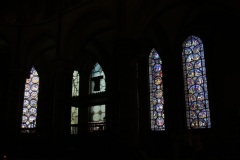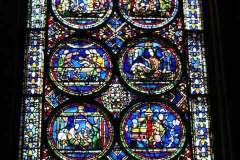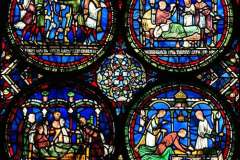There were originally 12 Miracle windows, six on the north side and six on the south side of the shrine of St Thomas in the centre of the Trinity chapel. All the windows were complete by the time the Translation of St Thomas’ remains from the crypt to the Trinity chapel on 7th July 1220 (Image 1)
As in the north windows, there are scenes portraying miracles that were seen to have occurred as a result of prayer to, or the intervention of, St Thomas.
From the east, the glass in the first window is original (Image 2), the next two are clear glass as the original glass is lost; the fourth window has only two original roundels at the bottom but one is the famous scene of pilgrims making their way to Canterbury, one on horseback and others walking. The fifth window has scenes from various windows but no complete stories; the final, sixth window has the original early 13th century glass.
There are many scenes portrayed in these four original windows and they can be explained by comparing the accounts recorded by the monks of the stories told by pilgrims who came to the tomb in the crypt in the late 13th century. It is therefore possible to identify some of the characters in the windows such as their names, where they came from, their ailments or conditions and how these were changed by prayers to or intercessions of St Thomas; some scenes are explained with Latin inscriptions. Perhaps the most well known window in this part of the Cathedral is at the bottom of the fourth window and is a roundel showing pilgrims on the way to Canterbury, one on horse back and three walking.
What to see (selecting one story):
In the first window, the story of Adam the forester is told in the four lowest roundels, (Image 3); it starts with the second roundel up on the left side. In this roundel there are two foresters Adam, on the left, is shot in the neck by an arrow that has been fired by a poacher in green centre right holding the bow, the second forester second left has an axe in his belt; another poacher on the right is walking away with a deer slung over his shoulder. In the background there are two trees, one tree would have symbolised a garden but as there are two trees this is a forest; this is the king’s forest and the penalty for poaching is death, hence the poachers violent reaction to the presence of the forester whose job it is to protect the forest.
Below in the next roundel, Adam is in bed surrounded by his friends in the King’s castle as shown by the castellations on the posts behind;
In the roundel up one and on the right, Adam is drinking ‘Canterbury water’ containing blood of the martyr, this was dispensed to pilgrims to effect cures.
In the final scene, bottom right, Adam has recovered and is giving thanks at St Thomas’ tomb for his recovery.
The roundel at the bottom of window number four, counting from the left, of pilgrims.
Sources: see standard cathedral sources
AT



